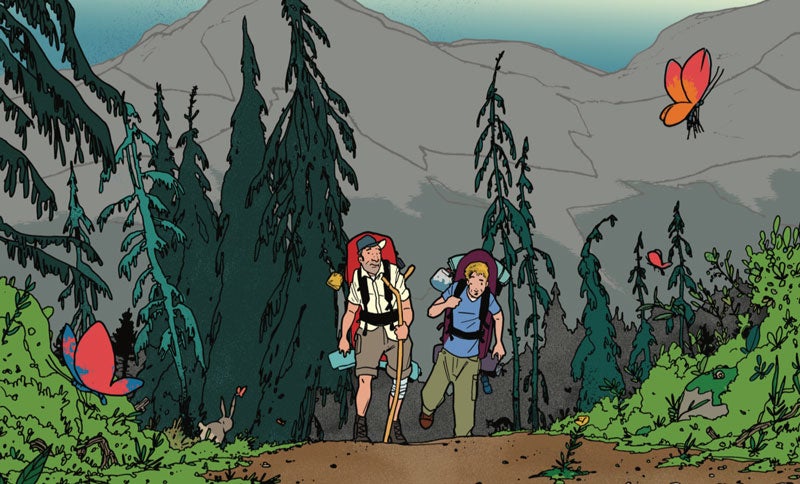Pass/Fail: Hike the John Muir Trail

'Illustration by Jason Schneider'
The look on my older brother’s face said it all. As he buckled on his fully-loaded, 75-liter pack at the trailhead in Yosemite Valley, he sagged under the weight and gawked at me, as if to say: “This thing? For 20 days?”
Nick and I had a total of six nights backpacking experience between us, and two of mine were from middle school. Most of our gear still had that fresh-off-the-shelf smell. And even if the equipment worked, I wasn’t 100-percent sure that my New York-trained palate could survive three weeks of trail mix and dehydrated dinners.
No doubt many expert sources—including this magazine—would say that we should start with something smaller, that we weren’t prepared for a thru-hike of the 211-mile John Muir Trail. But we were as ready as our hectic schedules allowed. The time was now.
The urgency we both felt was four decades in the making. In 1975, our dad, Bob Danza, took 25 days to thru-hike the JMT. More than 30 years later, after he lost his battle with cancer, he left behind a trail of mementos—a journal, his old kit, and an itinerary scribbled on a sheet of paper—that led us to this trailhead. As kids, we’d squirm when he made us sit through slideshows of his trip. But as adults, we realized there was no better tribute than to follow in his footsteps—experience be damned.
Though we did try to get prepared. We bought maps and guidebooks. We diligently studied the trail and online reports and memorized landmarks and waypoints. We researched gear, slowly built our kits, and eventually created a 20-day plan of our own. But we each only went out for a few days to practice.
After arranging our three resupplies, we started on a warm July morning. If our success was to be measured by mistake-free hiking, the first few days did not go well. I lost my headlamp. Nick yanked the buckle off his pack cover the very first time he tried to cinch it tight in a rainstorm in Tuolumne Meadows. I smooshed a banana inside my pack’s top lid. Nick went overboard with the duct tape and nearly ripped all the skin off his ankle. I found out the lid of my bear canister wasn’t waterproof by leaving the can right-side up in the rain.
Perhaps not surprising, our fitness training had been haphazard. On top of that, I was coming from sea level and struggled with the altitude right away. I bonked every afternoon the first few days. And when I began feeling better, Nick’s knee started screaming at him on every downhill—of which the JMT has many.
But these flubs weren’t trip killers. They were “learning opportunities.” And while the skeptics would have felt vindicated by our clumsy progress, there was no denying that we were making progress. After a massive thunderstorm chased us off Muir Pass, we pushed one another, achieving our longest day—more than 19 miles—and earning an unplanned (but much needed) zero day in Le Conte Canyon. We’ll never forget that campsite, guarded by rows of granite walls, with a resident doe and her two fawns for company. We enjoyed the rest, the views, and even foraged some Sierra onion for our dehydrated dinners.
The second half of the hike went better, but I can’t say the naysayers wouldn’t have found shortcomings. Our packs never looked like the neat, symmetrical models we saw on other hikers. And though we finally managed to pack up camp faster than our first week’s average of two hours, it wasn’t by much. Nick never did manage to pitch his single-wall tent correctly, and even poked holes in the bug netting trying to get it right.
But we grew stronger and more trail-wise with each mile. Best of all, our inexperience couldn’t make the Sierra less amazing, the glacial lakes less cleansing, or the bonds we built less meaningful. And after 211 miles, when we hiked the final day in nothing but our boots, hats, and underwear, it wasn’t because we’d made some rookie mistake and lost our clothes. It was just something our dad would have done.
The Verdict: PASS
Nick and I made plenty of beginner mistakes, but we did our research, planned a doable pace, and kept each other motivated. At the end, we still weren’t experts, but when we hiked down from Mt. Whitney, hooting and hollering just for the joy of being alive, I bet nobody could tell.
How to Hike the John Muir Trail Like a Pro
Despite the author’s success, would-be thru-hikers would be wise to master the basics before tackling this 211-miler. But whatever your experience, use these tips to make your journey a good one.
Ease in Travel north to south, so you can acclimatize to the latter half’s higher elevations.
Carry less Resupply food (and fresh socks!) at Tuolumne Meadows, Red’s Meadow, and Muir Trail Ranch.
Get fitThe JMT has more than 75,000 feet of elevation change. Get a workout plan.
Splurge The $165/night tent-cabins at Muir Trail Ranch do wonders for sore muscles and lagging spirits.
Stay positive Beginners should be careful not to indulge each other’s fantasies about quitting.
Get a permit Fax your application to Yosemite National Park so that it arrives before 7:30 a.m. PST on the day that falls 24 weeks in advance of your planned departure.
Thru-Hike Success Plan
Yes, you can make mistakes and still hike the JMT. Or you can take a class and avoid the setbacks many beginners suffer. Take our self-paced online thru-hiking class and learn tips and tricks from veteran thru-hiker Liz “Snorkel” Thomas.